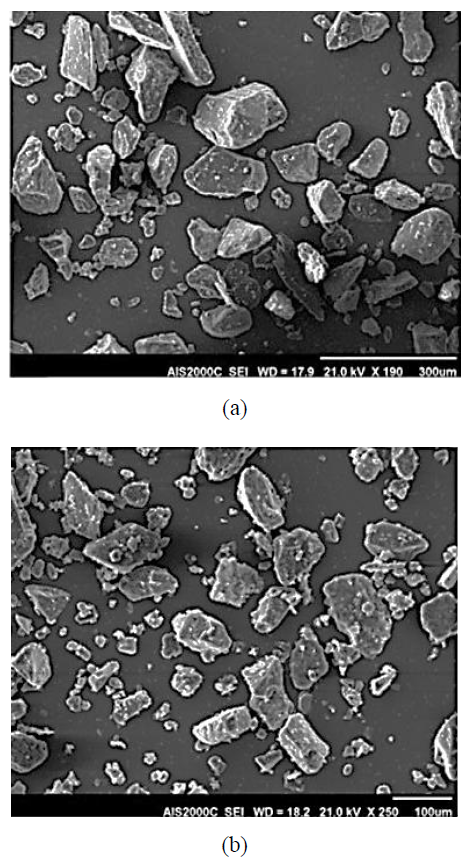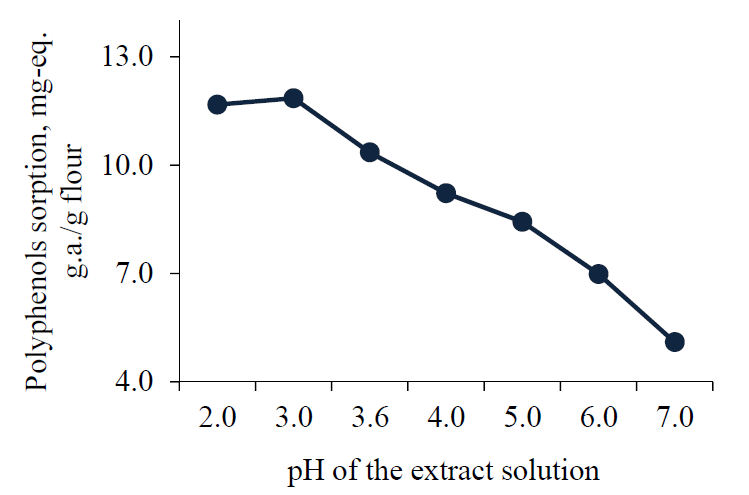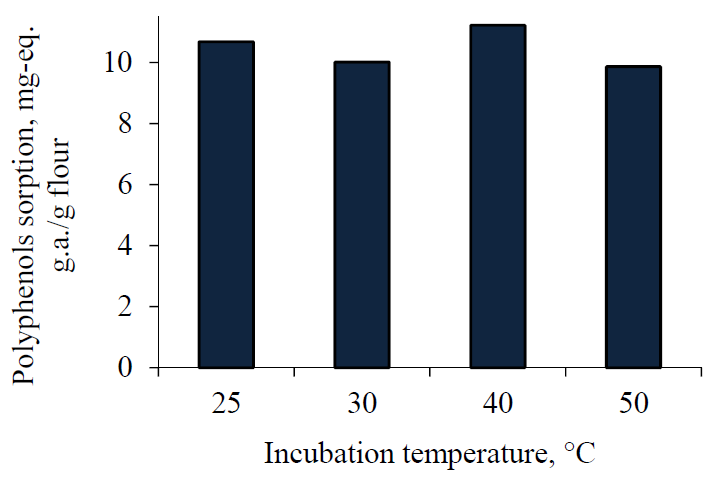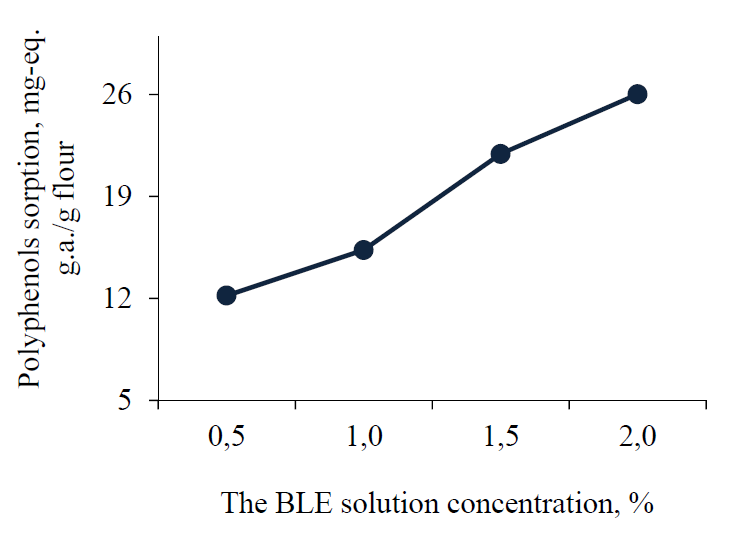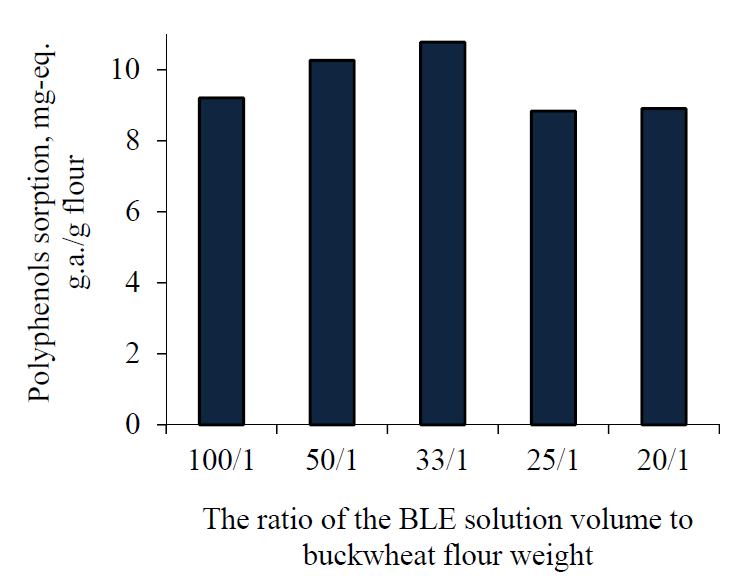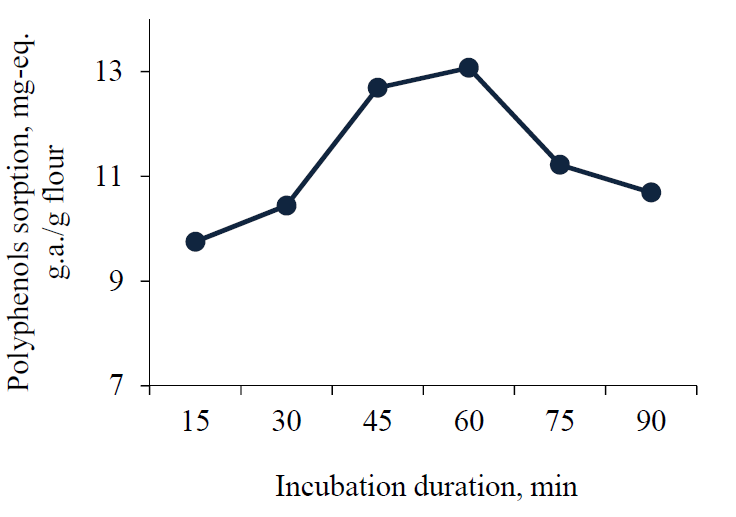Аннотация
An innovative approach to creating a new generation of specialised foods for dietary therapy of type 2 diabetes can involve planned adding of plant polyphenols to their formulafions. The marked antioxidant properties of polyphenols largely determine their potential antidiabetic effects. However, the use of food polyphenols for prophylactic purposes is limited by their low bioavailability, which makes it expedient to search for technological approaches aimed at obtaining polyphenolic matrices with high biological activity, increased digestibility, and stability. This study objective was to purposely extract and concentrate the polyphenols by sorbing them from an aqueous solution of the bilberry leaf extract (BLE) on buckwheat flour and to assess their storage stability. A number of experiments on optimal parameters selection for sorbing polyphenols from the BLE on buckwheat flour were performed. The parameters included the concentration of the extract solution, the solution/sorbent ratio, the pH of the solution, the temperature and the time of sorption. The sorption on the polyphenol matrix was determined from the difference in their contents in the initial solution of the extract and in the supernatant after centrifugation by the Folin-Ciocalteu method. The effects of exposure to light, temperatures, and humidity on the polyphenol compounds in the dry BLE and in the food matrix contents during storage was analysed by the FTIR spectroscopy. The experiments determined the optimal conditions for the BLE polyphenol sorption on buckwheat flour by incubation of a 2% BLE solution pH = 3.6 with the portion of buckwheat flour at the ratio of 1g/50 cm3 solution for 45 minutes at 25°C. When storing the food matrix, there was no significant degradation of the polyphenolic compounds in the food matrix, which indicates an increase in the stability of the polyphenols sorbed on buckwheat flour. This paper presents the results that are scientifically and practically relevant for the nutritiology experts who devise promising technological approaches to expanding the range of functional food ingredients of the antidiabetic character.Ключевые слова
Diabetes, polyphenols, bioavailability, bilberry leaf extract, buckwheat flour, sorption, food matrix, functional food ingredientВВЕДЕНИЕ
Diabetes mellitus (DM) is one of the most common endocrine diseases, characterised by a steady morbidity increase, a high incidence of vascular complications leading to early disability, high mortality, and significant economic costs of medical and social care [1]. An essential part of preventing DM as an alimentary-dependent disease and its clinical manifestations is optimising and personalising dietary prevention, which involves developing new functional and specialised food products (SFPs) that correct the carbohydrate and lipid metabolism disorders in a specific way [2]. The innovative approach to the development of a new generation of SFPs for diet therapy of type 2 diabetes can be the usage of plant polyphenols as functional food ingredients (FFI) in their contents, i.e. minor biologically active substances (BAS) with proven in clinical and in vivo studies pronounced hypoglycemic, hypocholesterolemic and antioxidant properties [3]. For many years clinical research and experiments on laboratory animals with induced or genetically determined diabetic manifestations and have been studying the hypolipidemic, and hypoglycemic properties of individual plant polyphenols as such or within the extracts [4]. Using plant polyphenols in metabolic disorders is proved very promising by the study results evidentiating their effectiveness and safety through the implementation of one of the main principles of phytotherapy, namely: act not only on the affected organ, but also on the body's conjugate systems [5, 6]. According to contemporary theories, the pathogenic basis of type 2 diabetes includes two major disorders: developing the insulin resistance in the peripheral target tissues and reducing insulin secretion. Hyperglycemia and glucose autooxidation cause the oxidative stress, which in turn damages phospholipids in the plasma membranes of the target tissues and beta cells of Langerhans islets. Thusan, inevitable "vicious circle" characterised by a systemic metabolic disorder and concomitant clinical complications arises. The marked antioxidant properties of polyphenols largely determine their potential antidiabetic effects. The polyphenol influence on the cellular level is determined by the interaction with the cell membranes, which modulates the phase state of the membrane lipids and its structural organisation [1, 7]. There is no doubt that polyphenols influence the nuclear and cytoplasmic proteins expression. An important component of the physiological activity of polyphenols is their participation in signaling systems of the cell [1]. However, a widespread use of the proven properties of food polyphenols for prophylactic purposes is limited by their very low bioavailability, often not allowing achieving the expected beneficial effects in carbohydrate and lipid metabolism disorders in clinical conditions. So, after a normal meal, the concentration of the metabolites from the phenolic compounds in the blood rarely exceeds 1 nM, although in the gastrointestinal tract it can amount to over 1 mM [8]. Thus, it is obviously expedient to obtain the FFI with the highest possible polyphenol content. The modern priority in increasing the efficiency for the polyphenolic SFPs includes a wide range of technological solutions, such as using microspheres and microcapsules as transport; producing solid dispersions; practicing administration of polyphenols with substances "enhancing" their absorption; generating phospholipid-polyphenol complexes, and polyphenol-protein complexes [8]. Sorbing polyphenols from berry juices and plant extracts on based of soy flour increases their stability and prolongs their shelf life, as shown in [9–11].
Due to the wide range of polyphenols in bilberry leaves, this plant extracts are customarily used in traditional medicine to reduce the symptoms of diabetes mellitus [12]. Previously, we tested hypoglycemic and hypolipidemic properties of an aqueous solution of the BLE when it had been administered intragastrically to the genetic line of obese rats Zucker Rats Crl: ZUC-Leprfa rats in a dose of 2 g/kg of the animal's body weight for 28 days. Theextract consumption helped improve the response of the insulin-sensitive tissues to the exogenous administration of glucose and insulin and prevented the increase of blood glucose level [13].
This study objective was to purposely recover and concentrate the polyphenols by sorbing them from an aqueous solution of the BLE on brown buckwheat flour, to assess their storage stability in order to justify the possible use as a FFI in the SFP contents. Accordingly, the research objectives included, first, determining the optimal sorption conditions by varying the concentration ratio of polyphenol extract and flour weights, pH values of the incubation mixture, adsorption time, and parameters of the protein matrix microstructure. Secondly, conducting a comparative analysis of the degradation kinetics for the polyphenols in a solution of the BLE and the polyphenols sorbed on brown buckwheat flour (hereinafter referred to as the food matrix) when stored at the specified temperature and humidity. The choice of the brown buckwheat flour as the absorbing matrix for polyphenols is conditioned by its use in modern medical practice as a diet ingredient for obesity, diabetes, kidney disease, with the view of lowering cholesterol and total lipids, and strengthening the blood vessel walls [14].
ОБЪЕКТЫ И МЕТОДЫ ИССЛЕДОВАНИЯ
The dry bilberry leaves extract (OOO "KHARMS", St. Petersburg, Russia) with a moisture and ash contents of 61% and 16.8%, respectively, was the sbudy object. The total contents of flavonoids and hydroxycinnamic acids are 13.67 ± 0.11 mg/g and 11.68 ± 0.22 mg/g, pespecfively. The total content of proanthocyanidins equals 15.5 ± 0.22 mg/g [15]. The content of polyphenol compounds expressed in mg-eq. of gallic acid is 95.5 ± 1.1 mg-eq. g.a./g extract.
An experimental sample of brown buckwheat flour was obtained by grinding an industrial batch of food flour (OOO HLEBZERNOPRODUKT, Taganrog, Russia) by means of a knife grinder GRINDOMIX GM200 (Retsch, Germany) at 8000 rpm for 10 min. Mass content of protein in the sample was 9.7%; carbohydrates, 70.0%; ash, 1.6%; and moisture, 5.5%.
Granulometric characteristic.The granulometric parameters of the brown buckwheat flour sample and the food matrix were determined by electron-scanning microscopy. The samples were applied in a thin layer on a stage with a double-sided conductive tape, followed by ion-plasma spraying of gold to increase the contrast of the image. The micrographs were obtained with a scanning electron microscope AIS 1800C (Seron Technologies Inc) in the secondary electron mode in a high vacuum. By means of the obtained micrographs, the criteria for the size and shape of the particles were calculated: equivalent radius (characterises the average particle size of an irregular shape) and ellipticity (characterises the deviation degree for the shape of a particle from a spherical one), according to formulas
Equivalent radius:

Ellipticity:
![]()
where, l is the length of the particle, b is the width of the particle.
To compare the values obtained between the groups, the Kruskal-Wallis nonparametric test was used.
Determining the optimal sorption conditions. The polyphenols sorption from the aqueous solutions of the BLE on brown buckwheat flour was conducted with a constant stirring of the incubation mixture on a magnetic stirrer, and after the incubation, the centrifugation of the resulting suspension (a centrifuge Beckman J6B (AL-TAR, USA)) at 4000 rpm for 20 min took place. The supernatant was separated from the precipitate by decantation. The precipitate was freeze-dried by means of a LS-500 unit (OOO "PROINTEH", Russia). The dependence of polyphenols sorption on flour the pH value of the incubation mixture was determined with the help of a flour sample of 1g in 50 cm3 of the incubation mixture of a 0.5% extract solution at a pH range of 2.0–7.0. The sorption took place for 30 minutes at a temperature of 25°C. The sorption dependence on the incubation time of the mixture was determined by means of a 0.5% extract solution in the time interval of 15–90 min at a pH of 3.6, a temperature of 25°C, using a flour sample of 1 g. The sorption dependence on the incubation temperature of the mixture was determined using a flour sample of 1 g in the mixture of 50 cm3 of a 0.5% extract solution at a pH of 3.6 for 30 min in the temperature range of 25–50°C. The sorption dependence on the extract solution concentration was determined in the range of 0.5–2.5% at a temperature of 25°C, and pH of 3.6 for 30 min using a flour sample of 1 g. The stoichiometric analysis of the polyphenol sorption on brown buckwheat flour was conducted by mixing 100 cm3 of 0.5% extract with different amounts of flour (1–5 g) for 30 min at a temperature of 25°C and pH of 3.6. The specific content of total polyphenols sorbed on the flour, expressed in mg equivalent of gallic acid (as indicated below), was calculated from the difference in their content in the initial extract solution and in the supernatant after centrifugation.
Evaluating polyphenols stability in the dry bilberry leaves extract and as a part of the food matrix. Half the samples of the dry BLE and the samples of polyphenols in the food matrix were placed in a climate chamber (manufactured by POL-EKOAPARATURA, Poland) at 50°C and a relative humidity of 50%. The second half was kept at the same temperature and humidity conditions with an additional exposure to light. The studies were conducted for 7 days. The control points for sampling after the beginning of loading into the climatic chamber were as follows: 16 h, 24 h, 40 h, 48 h, 64 h, 72 h, 88.5 h, 136.5 h, 144 h, 161 h.
Measuring the total polyphenols. The contents of total polyphenols in the analysed solutions of the BLE and supernatants, sampled after the sorption, was determined spectrophotometrically by the Folin- Ciocalteu method [16]. The optical density of the solutions was measured at a wavelength of 765 nm using a spectrophotometer SpectroQuest 2800 (UNICO, USA). In the solutions, the concentration of total polyphenols in mg-eq. g.a. was determined by means of a calibration curve obtained by using a gallic acid standard (97.5%, Sigma, USA).
Measuring polyphenols desorbed from the food matrix. A 0.5 g portion of the food matrix was placed in a 20 cm3 vial the adsorbed polyphenols were eluted with 8 cm3 of a 1% solution of glacial acetic acid in 80% ethanol in an ultrasonic bath “Sapphire 2.8 TTC” (OOO “Sapphire”, Russia) for 5 minutes at 55°C. The mixture was centrifuged at 4000 rpm for 10 min, and the supernatant was transferred to a pear-shaped flask. The elution in the same mode was repeated twice more. The eluates were combined, and the alcohol was evaporated on a rotary evaporator IR1M3 (OAO “Khimlaborpribor”, Russia) at 60°C to achieve 15% of the initial volume of the combined eluents. The resulting concentrate was transferred to a graduated cylinder, the volume was adjusted to 50 cm3 with distilled water. In the obtained solution, the content of total polyphenols was determined by the Folin- Ciocalteu method.
Measuring the kinetic parameters of polyphenols degradation. The effects of exposing the polyphenolic compounds in the dry BLE and in the food matrix to light, temperature, and humidity were analysed by the IR Fourier transform spectroscopy using a spectrometer Tensor 27 (Bruker Optik GmbH) and an adapter MIRacleATR (Attenuated total reflection, ATR), and using a software Opus 6.0 [17]. Study parameters: a resolution was 4 cm-1, the number of scans equaled 64, and the scanned area ranged from 4000 cm-1 to 600 cm-1. Before measurement, the samples were ground in an agate mortar until a uniform consistency was obtained. Each sample was analysed in 4 replicates. The obtained spectra were processed in an automatic mode, including the following steps: the error correction of the ATR spectrum, the correction of moisture and carbon dioxide contents, reduction to the baseline, and normalisation. The calculations used the average value for the three spectra closest to each sample. To determine the kinetic characteristics during oxidation, the second derivative was calculated at 13 smooth points. The spectra of the second derivatives were analysed in two bands: in the range of 1725–1731 cm corresponding to a strong band of stretching vibrations of the carbonyl group of the -CH2-CHO aldehyde group; and also in the range of 2920–2960 cm corresponding to the strong band of absorption for valence antisymmetric vibrations of -CH2 bonds [18].
Calculating the kinetic parameters for the accumulation of polyphenol degradation products was carried out by the first-order equation for the reactions [19]:

The half-transformation period for the functional groups studied, respectively, was determined by the equation:

Preparing a functional food ingredient (FFI) in experimental quantities. To carry out experiments to assess the stability of the BLE polyphenols sorbed on crushed buckwheat flour, a 200 gr batch of food matrix was obtained. An experimental flour sample of 120 g and the dry BLE of 120 g, which was dissolved in 6 dm3 distilled water (2% solution) were used for this purpose. Then the solution was acidified with 1N HCl to pH of 3.6, centrifuged at 3000 rpm for 10 min. After this, a slight insoluble precipitate was removed, and 120 g of an experimental flour sample was added. The sorption was carried out at 25°C for 45 minutes with a constant stirring, then the mixture was centrifuged at 4000 rpm for 20 min, the precipitate was separated from the supernatant by decantation. Subsequently, 50 cm3 of distilled water was added to the precipitate, the mixture was stirred for 5–7 minutes and centrifuged at 4000 rpm for 10 min. The precipitate (food matrix) was separated from the supernatant by decanting and freeze-drying. The food matrix yield was 100 g. The content of the polyphenols in the food matrix was determined by eluting the polyphenols according to the procedure described above.
РЕЗУЛЬТАТЫ И ИХ ОБСУЖДЕНИЕ
To carry out experiments to optimise the conditions for sorbing the BLE polyphenols on flour, an experimental batch of buckwheat flour was obtained, ground on a knife mill GRINDOMIX GM200 (Retsch, Germany) at 8000 rpm for 10 min. The average particle size of the initial sample of flour was 181.6 ± 5.1 μm, the average particle size of the ground flour was 134.9 ± 3.9 μm (Fig. 1).
Fig. 2 shows the graph of dependence of the polyphenols sorbing on the ground buckwheat flour on the pH of the incubation mixture. With an increase in pH from 2.0 to 7.0, there was a decrease in the average values of sorption of the BLE polyphenols from 1.7 ± 0.8 to 3.5 ± 0.4 mg-eq. g.a./g flour.
Changing the incubation temperature in the range of 25–50°C had no significant effect on the sorption efficiency, as follows from the data presented in Fig. 3.
Fig. 4 shows the graph of dependence of the sorption of the BLE polyphenols on their concentration in the incubation mixture.
With an increase in the concentration of the BLE polyphenols in the range of 0.5–2.0%, an increase in sorption is observed ranging from 12.1 ± 0.8 to 26.0 ± 1.6 mg-eq. g.a./g flour. With a further increase in the BLE concentration, gelling occurred, which prevented a correct evaluation of sorption.
Fig. 5 presents the data on the dependence of the BLE polyphenols sorption on the ground buckwheat flour on the ratio of the solution volume and the flour weight.
The change in the ratio of the BLE solution volume/buckwheat flour weight from 100/1 to 20/1 did not have a significant effect on the BLE polyphenols sorption (Fig. 5).
Fig. 6 shows the graph of dependence of the polyphenols sorption on the incubation duration.
With an increase in the incubation duration from 30 to 60 min, the polyphenols sorption increased from 10.44 ± 0.40 to 13.07 ± 0.26 mg-eq. g.a./g flour. A further increase in the incubation time led to an unreliable decrease in sorption.
To carry out an experiment to assess the degradation degree of the BLE polyphenols in the food matrix during storage, an experimental batch of the product was obtained. The content of polyphenols in it was 23.7 ± 0.5 mg-eq. g.a./g flour.
Upon storage of the initial dry BLE for 72 h, the content of polyphenols decreased from 95.5 ± 1.1 mg-eq. g.a./g extract in the original sample to 86.1 ± 0.7 mg-eq. g.a./g extract when stored in the dark and up to
88.4 ± 1.3 mg-eq. g.a./ g extract when stored in the light. The further storage did not change these values. When storing the food matrix, both in the dark and in the light for the whole period (161 h), there was no reliable decrease in the polyphenols content expressed in gallic acid equivalents (22.9 ± 0.2 mg-eq. g.a./g flour).
The representative curves of the studied samples in the relevant ranges of wavelengths prior to the start of storage and at the end of the experiment are shown in Fig. 7a, b.
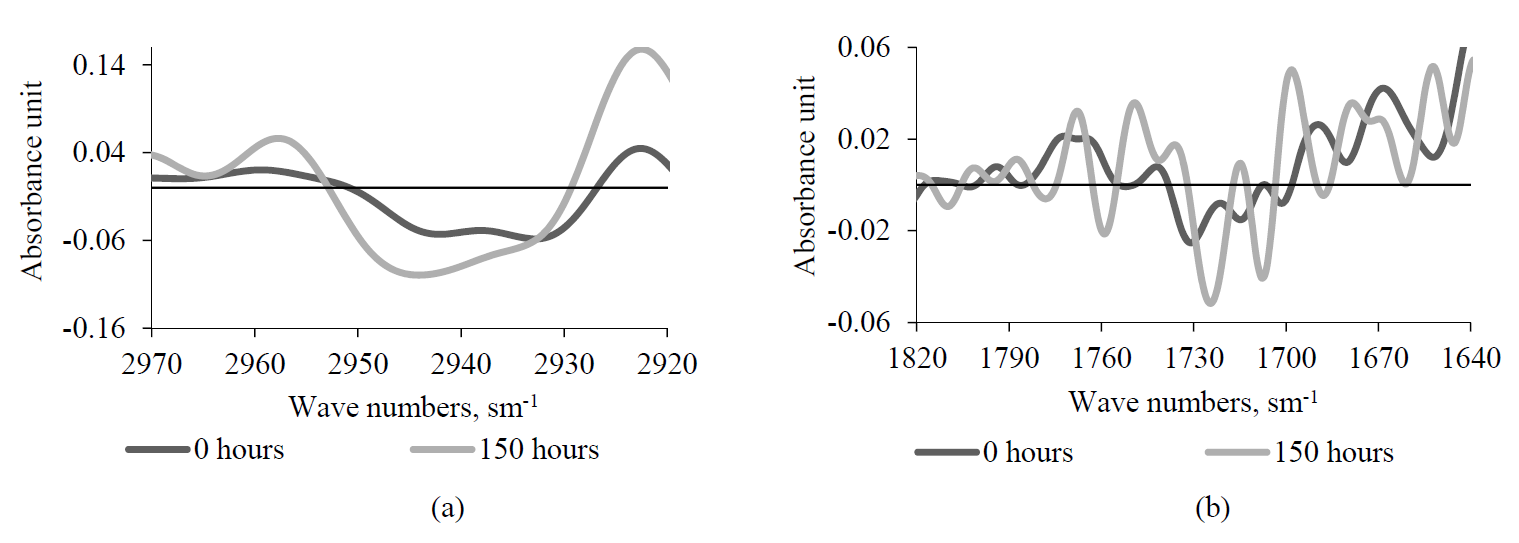
When studying the samples of the BLE and the complex during the storage, the influence of light on the degradation of polyphenols in them was not revealed.
The degradation of the polyphenolic compounds was more pronounced for the BLE, yet there were no significant changes revealed in the contents of the -CH2-CHO aldehyde group (oxidation of -OH polyphenol groups to the corresponding keto- (=O) groups) and -CH2-bonds (polymerisation accompanied by the formation of longer limiting aliphatic chains) from the complex with the protein matrix during storage.
Fig. 8 shows the accumulation curves for the functional groups under study, as well as the corresponding kinetic curves. The concentration of substances stands for the value of the area under the curve of the corresponding absorption band.
As one can be see from Fig. 8, a linear relationship exists between the logarithms of the functional groups concentrations and the storage time, which leads to the conclusion that the accumulation of these groups proceeds as the first-order reaction.
Thus, the kinetic parameters for the degradation of polyphenolic compounds in the BLE were obtained by calculation (Table 1).
The data obtained during the storage experiment with the samples evidentiate that the degradation rate for the polyphenols both in the BLE extract and in their complex with buckwheat flour does not depend on the light exposure at a temperature of 50°C and a relative humidity of 50%.
Polymerisation and oxidation of polyphenolic compounds from the BLE are the first-order reactions with the reaction rate constants k = 1.53 × 10-6 s-1 and k = 8.44 × 10-6 s-1 and the half-reaction period equal to t1/2 = 126 h and t1/2 = 22.8 h, respectively, at a temperature of 50°C.
ВЫВОДЫ
In the course of the experiments, the optimal conditions determined for the sorption of polyphenols from the BLE on buckwheat flour were defermined: the concentration of the extract solution was 2%, the solution pH was 3.6, the ratio of the flour weight and the extract solution volume was 1g/50 cm3, the temperature was 25°С, and the incubation time was 45 min. Under these conditions, the maximum value of the polyphenols sorption, determined by their elution from the food matrix, was 23.7 ± 0.5 mg-eq. g.a./g flour. The experimental batch of the food matrix was prepared by incubating the 2% BLE solution (pH 3.6) with the buckwheat flour (ground with the knife mill) at a ratio of 1 g/50cm3 solution for 45 min at 25°C. The obtained food matrix can be used as a functional food ingredient in the specialised food products that correct carbohydrate and lipid metabolism disorders.
Considering that the obtained FFI is a powder providing an unstable suspensions in water, it can be recommended to be used in food products having a dense food matrix. Examples of such products are fruit and vegetable purees, viscous dairy products, and flour based products.
When storing the food matrix for 161 hours at a constant temperature (50°C) and humidity (50%) with the exposure to light and without significant reduction in light, the reliable decrease in the polyphenols contents, expressed in equivalents of the gallic acid by the Folin-Ciocalteu technique, was not observed. According to the data obtained by the FTIR spectroscopy, there was no reliable degradation trend for the polyphenolic compounds of the food matrix, which indicated that the sorption of the polyphenols on buckwheat flour increased their storage stability significantly.
This paper presents the new results that are scientifically and practically relevant for the nutritiology experts, who devise promising technological approaches to expanding the range of functional food ingredients of the antidiabetic character.
КОНФЛИКТ ИНТЕРЕСОВ
The authors have no conflicts of interest to declare.
ФИНАНСИРОВАНИЕ
The study was funded by the Russian Science Foundation (project No. 14-36-00041).
СПИСОК ЛИТЕРАТУРЫ
- Tutelyan V.A., SharafetdinovKh.Kh., Kochetkova A.A., et al. Theoretical and practical aspects of dietary therapy at type 2 diabetes mellitus. Moscow: BIBLIO-GLOBUS Publ., 2016. 244 p. (In. Russ.).
- Alkhati A., Tsang C., Tiss A., et al. Functional Foods and Lifestyle Approaches for Diabetes Prevention and Management. Nutrients, 2017, vol. 9, no. 12, pp. 1310–1327. DOI: https://doi.org/10.3390/nu9121310.
- Tutelyan V.A., Kiseleva T.L., Kochetkova A.A., et al. Rastitelʹnye istochniki fitonutrientov dlya spetsializirovannykh pishchevykh produktov antidiabeticheskogo deystviya [Plant sources of phytonutrients for specialised foods of antidiabetic action]. Moscow: BIBLIO-GLOBUS Publ., 2016. 422 p. (In. Russ.).
- Mazo V.K., Sidorova Y.S., Shipelin V.A., et al. Polyphenolic plant extracts: effects on disorders of carbohydrate and lipid metabolism in laboratory animals. Problems of Endocrinology, 2016, vol. 62, no. 4, pp. 38–44. DOI: https://doi.org/10.14341/probl201662438-44. (In. Russ.).
- Blinkov I.L. Algorithm for the use of food plants for medicinal purposes. In: Kiseleva T.L. Therapeutic properties of food plants. Moscow: FSCECTMDT Roszdrav Publ., 2007. pp. 80–101. (In. Russ.).
- Bedekar A., Shah K., and Koffas M. Natural products for type II diabetes treatment. Advances in Applied Microbiology, 2010, vol. 71, pp. 21–73. DOI: https://doi.org/10.1016/S0065-2164(10)71002-9.
- Sobeh M., Mahmoud M.F., Petruk G., et al. Syzygiumaqueum: A Polyphenol-Rich Leaf Extract Exhibits Antioxidant, Hepatoprotective, Pain-Killing and Anti-inflammatory Activities in Animal Models. Frontiers in Pharmacology, 2018, vol. 9. DOI: https://doi.org/10.3389/fphar.2018.00566.
- Lewandowska U., Szewczyk K., Hrabec E., et al. Overview of Metabolism and Bioavailability Enhancement of Polyphenols. Journal of Agricultural and Food Chemistry, 2013, vol. 61, no. 50, pp. 12183–12199. DOI: https://doi.org/10.1021/jf404439b.
- Roopchand D.E., Grace M.H., Kuhn P., et al. Efficient sorption of polyphenols to soybean flour enables natural fortification of foods. Food Chemistry, 2012, vol. 131, no. 4, pp. 1193–1200. DOI: https://doi.org/10.1016/j.foodchem.2011.09.103.
- Roopchand D.E., Kuhn P., Poulev A., et al. Biochemical Analysis and in Vivo Hypoglycemic Activity of a Grape Polyphenol–Soybean Flour Complex. Journal of Agricultural and Food Chemistry, 2012, vol. 60, no. 36, pp. 8860–8865. DOI: https://doi.org/10.1021/jf300232h.
- Roopchand D., Kuhn P., Rojo L., et al. Blueberry polyphenol-enriched soybean flour reduces hyperglycemia, body weight gain and serum cholesterol in mice. Pharmacological Research, 2013, vol. 68, no. 1, pp. 59–67. DOI: https://doi.org/10.1016/j.phrs.2012.11.008.
- Kiseleva T.L., Tutelyan V.A., Kochetkova A.A., et al. Rastitelʹnye istochniki fitonutrientov dlya spetsializirovannykh pishchevykh produktov antidiabeticheskogo deystviya [Plant sources of phytonutrients for specialized food products of antidiabetic action]. Materialy Mezhdunarodnoy nauchno-prakticheskoy konferentsii, posvyashchennoy 55 letiyuTSNIL SibGMU ‘Molekulyi sistemy dlya diagnostiki I adresnoy terapii’ [Molecules and systems for diagnosis and targeted therapy: materials of the International Scientific and Practical Conference dedicated to the 55th anniversary of the Central Research Institute of the Siberian State Medical University]. Tomsk: Siberian State Medical University Publ., 2017. p. 50. (In. Russ.).
- Sidorova Y.S., Shipelin V.A., Mazo V.K., et al. Comparative studies of antidiabetic activity of bilberry leaf extract in Wistar rats with STZ-induced diabetes and Zucker diabetic fatty rats. International Food Research Journal, 2018, vol. 25, no. 3, pp. 1288–1294.
- Kiseleva T.L. and Kiseleva M.A. Buckwheat in Traditional Medicine and recent scientific findings: nutritive, energy and preventive properties. Potential allergological risk. Traditional medicine, 2016, vol. 3, no. 46, pp. 16–41. (In. Russ.).
- Zhogova A.A., Perova I.B., Samylina I.A., et al. Identification and Quantitative Determination of the Main Biologically Active Substances in Motherwort Herb by HPLC–Mass Spectrometry. Pharmaceutical and Chemical Journal, 2014, vol. 48, no. 7, pp. 461–466. DOI: https://doi.org/10.1007/s11094-014-1132-5.
- Tutelyan V.A., Ehller K.I., Aristarkhova T.V., et al. Metody analiza minornykh biologicheski aktivnykh veshchestv pishchi [Methods for the analysis of minor biologically active food substances]. Moscow: “Dynasty” Publ., 2010. 160 p. (In. Russ.).
- Ying D., Hlaing M.M., Lerisson J., et al. Physical properties and FTIR analysis of rice-oat flour and maize-oat flour based extruded food products containing olive pomace. Food Research International, 2017, vol. 100, pp. 665–673. DOI: https://doi.org/10.1016/j.foodres.2017.07.062.
- Larkin P. Infrared and Raman Spectroscopy 2nd Edition. Cambridge: Elsevier, 2017. 286 p.
- Sinela A.M., Mertz C., Achir N., et al. Exploration of reaction mechanisms of anthocyanin degradation in a roselle extract through kinetic studies on formulated model media. Food Chemistry, 2017, vol. 235, pp. 67–75. DOI: https://doi.org/10.1016/j.foodchem.2017.05.027.


